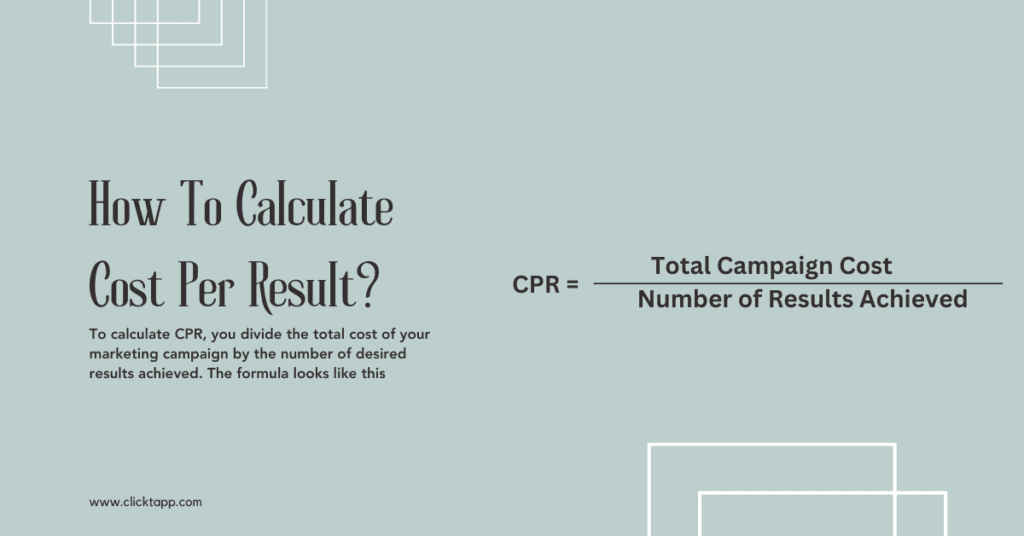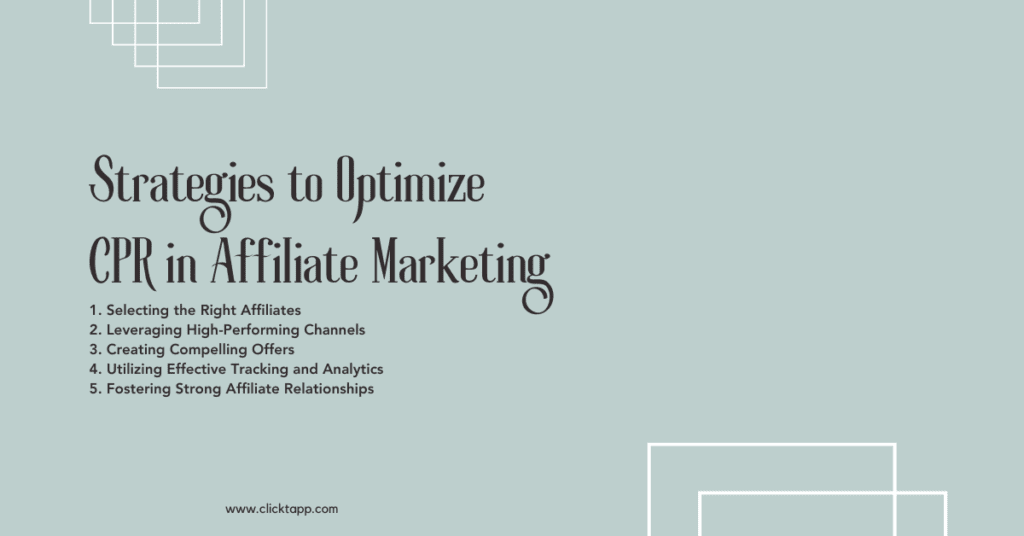CPR in Affiliate Marketing: A New Era for Affiliate Marketing
In affiliate marketing, a key metric is Cost Per Result (CPR). It shows the cost of getting each customer and the revenue from each sale. To find CPR, divide your marketing spend by the number of sales. This helps you spot wasteful spending and make smart budget changes.
Introduction to CPR in Affiliate Marketing
Cost Per Revenue (CPR) is key in affiliate marketing. It shows the cost of each sale or conversion. This includes affiliate efforts. It lets advertisers see their ROI. CPR is not the same as Cost Per Click or Cost Per Acquisition. Some aim for clicks or leads. CPR, however, ties costs to real revenue. It shows how effective and efficient a campaign is. Consider a bakery owner. They track the cost of bread. First, they divide the total cost by the number of loaves sold. It includes affiliate fees and ads. The result shows a direct effect of marketing costs on revenue. CPR results aren’t a sure sign of failure. It is due to higher product values or conversion rates. For example, spending more on a customer who buys a luxury item may lead to a high CPR. The revenue makes it worth it.
To improve CPR, marketers can get better commissions by negotiating. They can focus on high-value products and boost sales. We can do this by improving the site’s landing pages. They target their marketing. They use data to refine audiences.
Focusing on CPR helps marketers test their ads. They use resources well, cut costs, and lead in marketing.
What is Cost Per Result (CPR)?
Cost Per Result (CPR) is a key metric. It shows the cost of a specific marketing goal. It is better than old metrics like CPC or CPA. These only look at clicks or sales. CPR points to the bigger goals that add value to a business. These are: to get quality leads, more app downloads, and more newsletter sign-ups.
To find CPR, divide the total campaign cost by the results. Use a set time for this task. It shows how efficient marketing is. By tracking CPR, advertisers can improve their ads. They can adjust targeting, test channels, or improve conversions. It boosts results at a lower cost.
CPR is key in performance marketing. It targets actions that lead to real business results. It leads to better resource use and higher profits. For example, an e-commerce company can use CPR. It helps find the best sales channels. By targeting CPR, they can raise sales and lower costs. This will lead to higher profits.

Why is CPR Important?
CPR holds a pivotal role in affiliate marketing for several reasons:
- Budget Optimization: It helps advertisers allocate their budgets more effectively by identifying the most cost-efficient strategies and channels.
- Performance Measurement: CPR offers a clear measure of campaign performance, enabling advertisers to gauge the return on investment (ROI) of their affiliate marketing efforts.
- Strategic Decisions: Understanding CPR allows for informed strategic decisions, helping advertisers and affiliates fine-tune their approaches for better outcomes.
Calculating Cost Per Result
To calculate CPR, you divide the total cost of your marketing campaign by the number of desired results achieved. The formula looks like this:
CPR = Total Campaign Cost/Number of Results Achieved
This simple metric shows key data on your marketing power and performance. It sheds light on the campaign’s success.

Strategies to Optimize CPR in Affiliate Marketing
You can lower the Cost Per Result (CPR) in affiliate marketing. There are strategies to help. These aim to boost income and trim waste. First, choose high-value products with a high AOV. Examples are luxury watches and high-end software. They can justify higher CPRs. This boosts affiliates’ profits per sale. Negotiation is another tactic. Affiliates can ask for more commissions or bonuses. This is for sending in good leads. For example, getting many top leads can increase their commission.
We must improve conversion rates. It is vital. Make landing pages, calls-to-action, and user experiences better. A/B testing helps to find the best designs and messages. This enhances conversion rates.
Segmentation and targeting matter a lot. Use analytics to aim at those likely to convert. It cuts wasted ad spend and improves CPR. A fitness product affiliate might target those in health.
Check campaign performance and key metrics, like ROI and conversion rates. Do this often. It lets affiliates quickly enhance their CPR.
It’s key to diversify traffic sources and test new tactics. Some channels cost less than others. For some products, social media may be better than email. To lower CPR, we must test and improve our strategies.
By using these strategies, affiliates can manage CPR well. They can boost returns and grow their campaigns over time.
1. Selecting the Right Affiliates
- Niche Alignment: Partner with affiliates whose audience closely aligns with your target market.
- Performance History: Choose affiliates with a proven track record of high performance and reliability.
2. Leveraging High-Performing Channels
- Data Analysis: Use data analytics to identify which channels yield the best results for the lowest cost.
- Channel Diversification: Experiment with a mix of channels to find the most cost-effective combinations.
3. Creating Compelling Offers
- Value Proposition: Ensure your offers are compelling and provide clear value to the target audience.
- Testing and Optimization: Regularly test different elements of your offers (e.g., headlines, visuals, CTA) to optimize performance.
4. Utilizing Effective Tracking and Analytics
- Advanced Tracking Tools: Implement robust tracking solutions to accurately measure and attribute results.
- Data-Driven Insights: Use insights from analytics to make informed decisions that improve CPR.
5. Fostering Strong Affiliate Relationships
- Regular Communication: Maintain open lines of communication with your affiliates to share insights and strategies.
- Support and Resources: Provide affiliates with the necessary tools, resources, and incentives to succeed.

FAQs on CPR in Affiliate Marketing
1. What is the Cost Per Result (CPR)?
Answer: Cost Per Result (CPR) is a metric in digital ads. It measures the cost of getting a specific result from an ad, such as clicks or conversions.
2. How is Cost Per Result calculated?
Answer: CPR is the total spent on an ad campaign divided by the number of desired results.
3. Why is the cost per result important?
Answer: CPR helps advertisers understand the efficiency and effectiveness of their ad spend. It lets them check the ROI. Then, they can optimize their campaigns to get better results at a lower cost.
4. What factors can affect the cost per result?
Answer: Many factors can influence CPR. They are the target audience, ad quality, bidding strategy, competition, and ad relevance.
5. How can I improve my cost per result?
Answer: To improve CPR, refine your targeting, enhance your ads, and use smart bidding. Also, test and optimize your campaigns. High-quality, relevant content can also reduce CPR. Users dislike that.
6. What is a good cost per result?
Answer: A good CPR varies by industry and campaign goals. It also depends on the results being measured. A CPR of about $1.72 is good for Facebook ads. But, it can vary based on specific goals and benchmarks.
7. How does Cost Per Result differ from Cost Per Click (CPC)?
Answer: CPR measures the cost per desired result, like conversions. CPC measures the cost of each click on an ad. CPR provides a broader view of campaign efficiency beyond clicks.
8. Can cost per result be used for different types of campaigns?
Answer: Yes, CPR can apply to many campaigns, such as those for clicks, impressions, and conversions. It is a versatile metric. It helps assess campaign objectives.
9. How often should I check my cost per result?
Answer: Monitoring CPR regularly is important to ensure your campaigns are performing efficiently. Frequent monitoring lets you adjust quickly. This improves results and lowers costs.
10. What tools can help track cost per result?
Answer: Many ad platforms, like Facebook Ads and Google Ads, have tools to track CPR. Also, tools like MonsterInsights can help you track your campaigns’ CPR.


Pingback: CPS(Cost Per Sale) in Affiliate Marketing: The Ultimate Guide - Clicktapp
Pingback: Cost Per Install Demystified
Pingback: How to do Affiliate Marketing: A Comprehensive Guide - Clicktapp
Pingback: Cost Per Click (CPC): Strategies for Success - Clicktapp
Pingback: Email Marketing vs. Social Media: A Comparative Analysis - Clicktapp
Pingback: What Are SEO Keywords and How to Rank in 2025? - Clicktapp